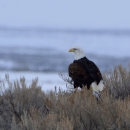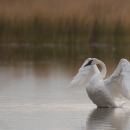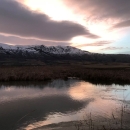About Us
Minidoka National Wildlife Refuge was established on February 25, 1909 as part of the executive order 1032 signed by President Theodore Roosevelt for the protection of “native birds.”
About half of the refuge’s 20,699 acres is open water and wetlands. In this arid landscape, these resources serve as an oasis drawing numerous wildlife species from miles around. Many species use the bulrush and cattail habitat that lines the lake’s small bays. Others use the willows, cottonwoods and other trees growing near shorelines. The rest of the refuge is low, rolling uplands covered by sagebrush sagebrush
The western United States’ sagebrush country encompasses over 175 million acres of public and private lands. The sagebrush landscape provides many benefits to our rural economies and communities, and it serves as crucial habitat for a diversity of wildlife, including the iconic greater sage-grouse and over 350 other species.
Learn more about sagebrush , grasses and isolated juniper patches amongst scattered outcrops of basalt.
The climate is semi-arid with about 11 inches of precipitation a year, much of it falling as snow during the winter. Summers are hot and dry with highly variable rain during thunderstorms. Winters are generally moderate but windy. The elevation is about 4200 feet.
The U.S. Fish and Wildlife Service manages the refuge. The U.S. Bureau of Reclamation operates the dam and power plant and controls the water levels in the reservoir. The Idaho Department of Parks and Recreation manages Lake Walcott State Park, a 30 acre park near the dam that offers campgrounds, picnic areas, a disc golf course, cabins, and a boat ramp. The park is a fee area.
Our Mission
The mission of the National Wildlife Refuge System is to administer a national network of lands and waters for the conservation, management and, where appropriate, restoration of the fish, wildlife and plant resources and their habitats within the United States for the benefit of present and future generations of Americans.
Every national wildlife refuge national wildlife refuge
A national wildlife refuge is typically a contiguous area of land and water managed by the U.S. Fish and Wildlife Service for the conservation and, where appropriate, restoration of fish, wildlife and plant resources and their habitats for the benefit of present and future generations of Americans.
Learn more about national wildlife refuge was created for a special purpose. Some were created to protect migratory birds, others to protect threatened or endangered species or unique habitats, while others fulfill another special purpose. All activities allowed on refuges must be evaluated to make sure each activity will not conflict with the reason the refuge was founded.
Our History
President Theodore Roosevelt created several refuges by Executive Order in 1909, including Minidoka National Wildlife Refuge. He stated the purpose of these refuges as "preserves and breeding grounds for native birds." Four subsequent Executive Orders by Presidents Taft, Hoover, and F.D. Roosevelt increased the size of Minidoka and added "other wildlife" to the refuge's purpose.
Key Dates
February 25, 1909 – Minidoka NWR is established by executive order 1032 signed by Theodore Roosevelt for “protection of native birds”
1935-1942- There was a Civilian Conservation Corps camp just west of the refuge office. The office and the stone walls in the park are all that remain of the camp that once had 18 buildings and held 200 men.
Oregon Trail
The North Alternate Branch of the Oregon Trail ran across the north side of the refuge. Although some stretches of the trail are now under water, ruts from the wagons can still be seen in many places. The main trail ran south of the Snake River and branched into the California and Oregon Trails in the Raft River Valley about one mile south of the refuge. Look for the white Oregon trail markers.
Minidoka Dam
The Minidoka Dam and Powerhouse are on the National Register of Historic Sites. During dam construction of the dam, there was a small village in what is now Lake Walcott State Park and another across the River.
Civilian Conservation Corps
The Civilian Conservation Corp's Camp Minidoka was located just west of the refuge headquarters from 1935-42. The headquarters building, the stone walls in the park, and the manager's residence are all that remains of the camp that once had 18 buildings and held 200 men.
Emigrants and Native Americans
Most emigrants considered the Snake River corridor an inhospitable place, hot and dry. To them, it was a place to get through, not to settle. To Native Americans, it was home, an area that they treasured. Many areas of the refuge were used by the native tribes for hunting, fishing, and day to day living.
Other Facilities in this Complex
Minidoka National Wildlife Refuge is managed as part of the Southeast Idaho NWR Complex. The Southeast Idaho National Wildlife Refuge Complex administers five units of the Refuge System: Bear Lake, Grays Lake, Camas, and Minidoka refuges, and Oxford Slough Waterfowl Production Area. The complex office is located in Chubbuck, Idaho, and can be reached at 208-237-6615.
Mailing Address: 4425 Burley Drive Suite A, Chubbuck, ID 83202


